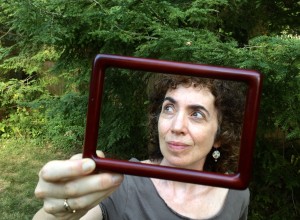 “How would you tell the story of what’s happening in this room?” I asked. “Depending on where you stand, you literally have a unique point of view.” I handed each person at my storytelling skills workshop a small rectangular cardboard frame.
“How would you tell the story of what’s happening in this room?” I asked. “Depending on where you stand, you literally have a unique point of view.” I handed each person at my storytelling skills workshop a small rectangular cardboard frame.
“Walk around the room and make choices about how you compose your shot,” I told them. “Step back to see a group of people, or get in close and focus on the expression of one person’s face. Stand up on a chair! Lie down on the floor! Look in from the doorway.”
Laughter burst out around the room as the participants “framed” each other and got creative with their “camera” angles.
“Notice how the angle of your gaze impacts the way you see things. Your perspective makes a difference. Every time you tell a story you make choices about what you focus on and the context you offer.”
I worked in film and video for 15 years before I became an oral storyteller, and I continue to think in terms of storyboards. Movie directors constantly make camera angle decisions – where to place the subject within the shot, whether to zoom in to a close up, or zoom out to a wide shot.
My sister Karen Marshall, is a photographer. She once gave me a tip on composition that was, well, eye opening. “Don’t just put your subject’s face in the center of the viewfinder,” she said. “Look around at all the outside edges and pay attention to how you frame the shot.”
Storytellers make analogous decisions. When I am creating a new story, I experiment with telling versions from different character’s points of view. This informs my telling, even if I later choose to tell the story in third person, in a narrator voice. But no narrator, or storyteller, is objective either. What context do I give the story? With what descriptive words do I paint pictures of place? Who do I select to be the main character of the story? What do I call attention to?
Here is an excerpt from my version of “The Fox and the Vineyard,” a story from the Jewish tradition. I have supplied the corresponding “camera” angles (in parentheses) for how I picture the story as I tell it.
“One evening at dusk, a fox stepped out at the edge of the woods” (establishing wide shot of landscape with fox in foreground)
“…his nose in the air.” (medium shot of fox sniffing)
“The fox, lean with hunger, intently followed the scent of something delicious.” (tracking shot of fox running)
[Gesture of fox’s head picking up scent] (POV of fox, medium close up shot from above)
“As the full moon was rising, the fox came upon a clearing” (wide shot of landscape)
“…and saw a high solid wall made of wood.” (POV of fox, shot from below, looking up at high wooden surface)
“It was a fence enclosing a large area.” (wide shot)
“’Oh, if only I could get in there.’ The fox smelled something so sweet and ripe and tantalizing.” (medium close up of fox pawing the ground outside the fence)
“The fox trotted around the periphery of this enclosure until he spied an opening at the bottom of the fence.” (tracking shot)
“He pushed his snout through” (medium shot from behind)
“…and finally with one eye could see in the moon light,” (close up of fox’s eye from in front)
“…vines full of ripe grapes.”(POV of fox, looking through opening)
“’If I could eat my fill I would be happy. If only I didn’t have to hunt for my food, my life would be so much better.’” (medium shot of fox sitting outside the fence)
There are countless storyboards one could make for the same sequence. Another storyteller might choose to give less description or not use dialogue. I choose to switch between a narrator voice and the voice of the fox so I can describe the scene and also give it a subjective feel. My personal storytelling style relies on physicality to convey characterization.
Unlike a movie where the audience watches only the director’s and editor’s choices, story listeners create their own unique “movie” in their imaginations. Some listeners may experience visual images or other sensory details. Some may be caught up in the emotions of the story. This interactive aspect of live storytelling is why I ultimately chose to be an oral storyteller and moved away from film and video. But I always try to include a full array of “camera” angles as I frame my stories.
copyright 2016 Cindy Marshall
